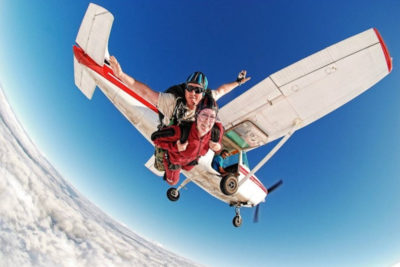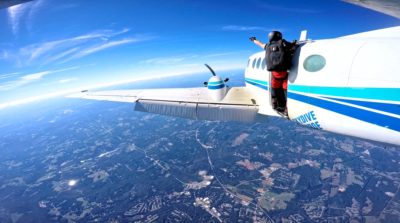So, it’s the day of your skydive and everything feels right. The weather is warm, there’s no wind, and the sky is filled with big, white clouds — it’s a beautiful day! You might think about how it would feel to go skydiving through a cloud and maybe even reach out and touch one of the nice fluffy ones. Alas, you show up to the dropzone and find out that no one will be skydiving through clouds. But, why? What happens if you skydive through a cloud? It’s a fair question, especially when it sounds so fun, but there are a few really good reasons why we don’t jump through clouds. Let’s get into it.
It’s Plane Cloudy
 The aviation industry is very strict when it comes to flying through clouds. The governing body, the Federal Aviation Association (FAA), enforces stringent rules for planes and pilots regarding cloud clearance – meaning how far an object legally has to stay from a cloud. In order for aircraft to be able to fly through clouds, they must have specific instruments and computers onboard for navigation when the pilots have limited or zero visibility.
The aviation industry is very strict when it comes to flying through clouds. The governing body, the Federal Aviation Association (FAA), enforces stringent rules for planes and pilots regarding cloud clearance – meaning how far an object legally has to stay from a cloud. In order for aircraft to be able to fly through clouds, they must have specific instruments and computers onboard for navigation when the pilots have limited or zero visibility.
For safety reasons, skydiving only takes place when weather conditions are just right – not too windy, not too cloudy, and definitely not at all rainy (more on that below). As such, skydiving planes are not typically equipped with these special instruments – plus, they add additional weight which would minimize the load capacity on those gloriously sunny, jumpable days. So, not only is skydiving not permitted when the weather is iffy, but it’s also not possible.
Head Out of the Clouds
For the same reason planes can’t fly through clouds, skydivers cannot legally fall through clouds. FAA cloud clearance requirements are actually the same for skydivers as they are for private pilots. According to Federal Aviation Regulation (FAR) Part 105.17:
No person may conduct a parachute operation, and no pilot in command of an aircraft may allow a parachute operation to be conducted from that aircraft —
(a) Into or through a cloud, or
(b) When the flight visibility or the distance from any cloud is less than that prescribed in the following table:
| Altitude | Flight Visibility (statute miles) | Distance from Clouds |
| 1,200 feet or less above the surface regardless of the MSL altitude | 3 | 500 feet below, 1,000 feet above, 2,000 feet horizontal |
| More than 1,200 feet above the surface but less than 10,000 feet MSL | 3 | 500 feet below, 1,000 feet above, 2,000 feet horizontal |
| More than 1,200 feet above the surface and at or above 10,000 feet MSL | 5 | 1,000 feet below, 1,000 feet above, 1 mile horizontal |
 The most relevant section for us in the skydiving community is the middle row that addresses altitudes of 1,200 feet above the surface and beneath 10,000 feet MSL (Mean Sea Level). Between those altitudes, a skydiver (or private pilot) must be able to see with an unobstructed view for three miles, and they must maintain a distance of 500 feet below clouds, 1,000 feet above clouds, and 2,000 feet horizontally away from clouds.
The most relevant section for us in the skydiving community is the middle row that addresses altitudes of 1,200 feet above the surface and beneath 10,000 feet MSL (Mean Sea Level). Between those altitudes, a skydiver (or private pilot) must be able to see with an unobstructed view for three miles, and they must maintain a distance of 500 feet below clouds, 1,000 feet above clouds, and 2,000 feet horizontally away from clouds.
In short – keeping the good times going means we must be in compliance with the Federal Aviation Regulations, or else we’re committing a federal violation. (No thanks!) So, no skydiving through or too near clouds… which is why you hear skydivers the world over wish one another “Blue skies!”.
Not Foggy About Safety
OK, let’s talk about safety concerns related to skydiving through clouds. While clouds, fog, or other circumstances leading to low-visibility would most likely be fine the majority of the time, it could also be potentially disastrous.
If you can’t see where you’re falling, you can’t see other skydivers, aircraft, or anything else that could cause a mid-air collision (obviously never a good situation). Your instructor also needs to see their altimeter – which shows the current altitude – to know when to deploy the parachute. Know, though, that the FAA requires all tandem skydiving rigs to be equipped with an AAD (Automatic Activation Device) which will automatically deploy the parachute should the canopy pilot fail to do so. Lastly, it’s critical to have an unobstructed view of the landing area so that you and your instructor know exactly where to touch down.
The Silver Lining
If you were daydreaming about falling through the clouds, we know that all of this information can be a downer. But we promise, skydiving through the sweet blue Georgia skies is so much better!
Puffy clouds (skydivers call them “puffies”) in the distance can make for a breathtaking view, and the perspective of falling near a towering cumulus cloud can be absolutely awe-inspiring. Falling through clouds is a completely different story – it’s gray opaque mist and nothing else – and they don’t feel any kind of magical, just like being outside on a foggy day. Boo!
Ready to be on Cloud 9? Join us for an epic skydiving adventure that will leave you feeling on top of the world and create memories that will last a lifetime. Blue skies!
Copyright © 2025, Skydive Monroe, All Rights Reserved.
DropZone Web Design & Marketing by Beyond Marketing, LLC



